June 6, 2013
by Carole Zangari -

We are happy to welcome Shareka Bentham back to our site with more AAC intervention ideas. Earlier in the year, she shared ideas for AAC intervention on a field trip to the zoo, playing Stop and Go, in therapy groups, and doing the Harlem Shake. In this post, Shareka uses a fun card game, Go Fish, to build vocabulary and help students learn to ask and answer questions. ::::::::::::::::::::::::::::::::::::::::::::::::::::::::::::::::::::::::::::::::::::::::::::::::::::::::::::::::: I have been working more frequently with a few more low tech devices recently, particularly with my older kids at school. We have started using the Go Talk 4+ and the Quick Talker 12 in class, (depending on the child’s level and ability) and have been seeing excellent results. One of my greatest challenges however has been finding ways to incorporate general vocabulary learning into AAC use, while keeping these older children engaged. These are the kids who are 7 years... [Read More...]
Filed under: PrAACtical Thinking
Tagged With: AACtual therapy, Shareka Bentham, therapy activities
June 5, 2013
by Robin Parker -

Strategy of The Month Communication Boards: Colorful Considerations Communication Boards Can Be Used For…. A Lot I Made A Communication Board: Bow What Join Together: Core & Fringe Vocabulary Fresh Look AAC in the Classroom with Joan Bruno Friendship Skills for Children Who Use AAC with Dr. Erinn Finke Top 5 Switches for People With ALS by Amy Roman AAC & Dementia with Dr. Melanie Fried Oken AAC for Children Who Have Rett Syndrome with Dr. Theresa Bartolotta AACtual TherapyHow We Do It Essential Tricks for Supporting AAC in Schools, Part 2 PrAACtical Look: AAC at Dynamic Therapy Associates by Vicki Clarke A Framework for Success Getting Started in the Exciting World of Communication & AAC with Marlene Cummings AAC Myth Buster Wrap-Up PrAActical Thinking It’s PrAACtically Better Hearing & Speech Month 30 Posts You May Have Missed for Autism Awareness Month It’s PrAACtically Mother’s Day- 5 Activities that Support... [Read More...]
Filed under: PrAACtical Thinking
Tagged With: communication boards, posts
June 4, 2013
by Carole Zangari -
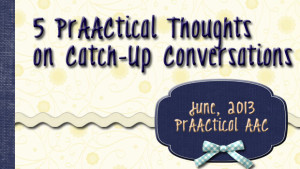
One of the things SLPs frequently do at the start of their therapy sessions is have some casual conversations with their clients to catch up on what happened since their last visit. Whether it is an elementary school student with ASD, a teenager with cerebral palsy, or an older adult with aphasia, we engage in polite conversation to find out what they’ve been up to and perhaps share a bit about our own experiences. Here are some thoughts on making those ‘catch-up conversations’ work from a prAACtical perspective. 1. Possible goal areas: initiate conversation; maintain dialogue on an established topic; redirect conversation to a new topic; respond to non-obligatory communication opportunities; use temporal terms in multi-word utterances; convey a personal narrative with a clear beginning, middle, and end; use regular past tense verbs; ask partner-focused questions 2. Core language targets: it, we, they, do/did, have/had, was/were, not It was (not);... [Read More...]
Filed under: PrAACtical Thinking
Tagged With: core vocabulary, fringe vocabulary, language goals, pragmatics, prompting, session planning
June 3, 2013
by Robin Parker -
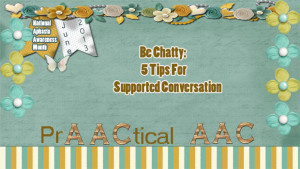
There are many strategies to support communication and conversation for individuals with significant aphasia. Conversation is about connecting with people. We engage in conversation about interesting and relevant experiences to help with connecting. To best connect and be part of conversation, there needs to be comprehension and expression from each communication partner. With aphasia, there is difficulty in these language areas, but it is not that language is lost, it is that it needs to be accessed differently. These quick start tips will support accessing conversation and connections. Write or Draw Key Words– When you are talking, write key words to support your spoken language. Gesture Key Words– When you are talking, supplement spoken language with gestures to illustrate a main point Show Related Photographs or Remnants– While you are talking, use photographs or some remnant of the an experience or event you are talking about. Written Choices to... [Read More...]
Filed under: PrAACtical Thinking
Tagged With: aphasia, augmented comprehension, augmented input, Supported Communication
May 31, 2013
by Carole Zangari -
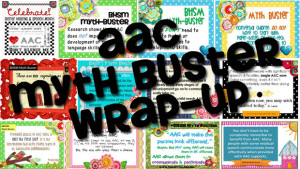
It stings to write this, but the truth is that in our country, students studying to become SLPs can graduate with little to no experience in AAC. While we’ve made some progress in getting more AAC into university SLP programs here in the US, we’ve really only scratched the surface. Given that a great many graduate without sufficient AAC knowledge, ASHA’s 2013 Better Speech and Hearing Month seemed like a perfect time to reach out to people who are relatively new in the field. I’m fairly certain that Dr. Lyle Lloyd, my doctoral advisor at Purdue University, was the first to talk about the mythology surrounding AAC, but many have followed that tradition. In a perfect world, we would have pre-planned our own myth busters and released them with pizazz in some sort of ordered fashion. But there was therapy to provide, student SLPs to teach, parents to talk to,... [Read More...]
Filed under: PrAACtical Thinking
Tagged With: ASHA, BSHM, download, myths
May 30, 2013
by Carole Zangari -
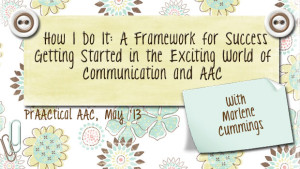
We couldn’t be more excited to have a return visit from Marlene Cummings, a wonderful SLP who is currently serving as an AAC Consultant to the AAC Team at Oakland Schools. In her first post, Marlene talked about strategies for cultivating the right mindset for AAC teaching. In this post, Marlene continues sharing elements of her Framework for Success in discussing the Knowledge Toolbox, developed with the Oakland Schools AAC Team. 5 Things in Your “Knowledge Toolbox” What is already in my “knowledge toolbox” of communication, language and learning? Yes, you do have a full toolbox. You just don’t realize it. And of course there are always new and exciting things to add. You already know this stuff!! REMEMBER??? It is important to step back and think broadly about communication and what it really does. Sometimes we get caught in the details of our work and can’t see the forest through the... [Read More...]
Filed under: PrAACtical Thinking
Tagged With: AAC team, classroom, communication opportunities, communicative competence, communicative function, communicative intent, education, How I Do It, language development, Marlene Cummings, schools
May 29, 2013
by Carole Zangari -
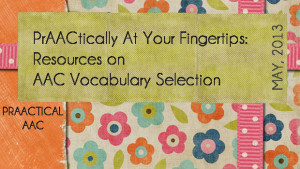
Need information on selecting vocabulary for someone with AAC needs? You can’t go wrong with Lauren Enders’ Pinterest board on this topic. She’s collected some wonderful posts, documents, and videos. Check it out here.
Filed under: PrAACtical Thinking
Tagged With: Lauren Enders, Pinterest, resources, vocabulary selection
May 28, 2013
by Robin Parker -
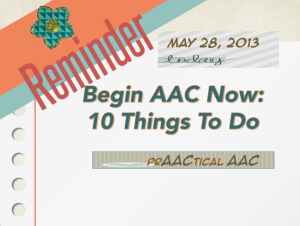
If you know someone with significant speech difficulties, BEGIN AAC NOW…. If you know someone, try something… Doing something, even if it isn’t perfect, is infinitely better than doing nothing at all…. There is no specific order for these suggestions, try what is appropriate and doable for you… A year from now you may wish you started today (K. Lamb)… So begin now at any level.. for someone, a class, a clinic, for a few… Create a Visual Language & AAC Environment: Visual Immersion Program, Meaningful Language Experiences, Importance of Using Visual Supports Speak AAC to the AAC Learner: Use Aided Language Input (ALI), Learning to Use ALI Get Assessment Information: Communication Matrix , AAC Evaluation Genie, Thoughts & Ideas, AAC Assessment Forms, Write & Implement Some AAC Goals: Goals That Matter, AAC in the IEP by Lauren Enders, PrAActical Goals Learn and Use a Core Word Approach: Core Word Communication Board Samples, About Core Words- First... [Read More...]
Filed under: PrAACtical Thinking
Tagged With: resources
May 27, 2013
by Carole Zangari -
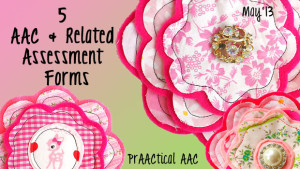
Ask any 10 professionals how they do AAC evaluations and you’re likely to get 10 different answers. We look for the same things (I think!) but go about it in different ways. We’re always happy to take a look at the protocols and forms that our colleagues develop and/or use. Here are some that might be of interest. 1. Bloom and Lahey Recording Sheet for staging language by Sherri Vernelso and Emily Pratt 2. Kate Ahern’s form for AAC device trials 3. SETT process assessment forms by HILIA Coordinators of Assistive Technology Services 4. The Functional Behavior Assessment Worksheet and Observation Forms by PaTTAN 5. Assessing the metaphoric use of pictures (e.g., Minspeak, Unity) protocol and forms by Gail Van Tatenhove If you have a protocol or form that you’d like to share, please get in touch. We’re always looking for new and better tools.
Filed under: PrAACtical Thinking
Tagged With: assessment, evaluation, forms, resources, testing
May 24, 2013
by Carole Zangari -
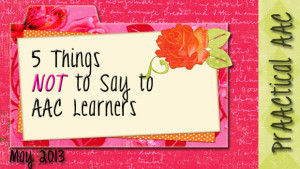
People who are learning to express themselves with AAC need to build their self-concept as competent communicators. One of the ways we can support that process is by being careful about the ways in which we refer to their communication. Here are a few things we try to avoid saying. “Show me [on your device].” (Instead, build the language of communication, with directives such as “Tell me” or “Say it.”) “Press the switch.” (Instead, refer to the function that the switch is being used for. E.g., “Make it go”) See Ian Bean’s great post on this subject. “Tell me on your talker.” (If they tell you one way, and you understood the message…celebrate, reward, and encourage! If you make them repeat themselves using a different strategy, they may come to view communication using AAC as a chore. And that’s not so good for motivation…) “I know you can do it.... [Read More...]
Filed under: PrAACtical Thinking









